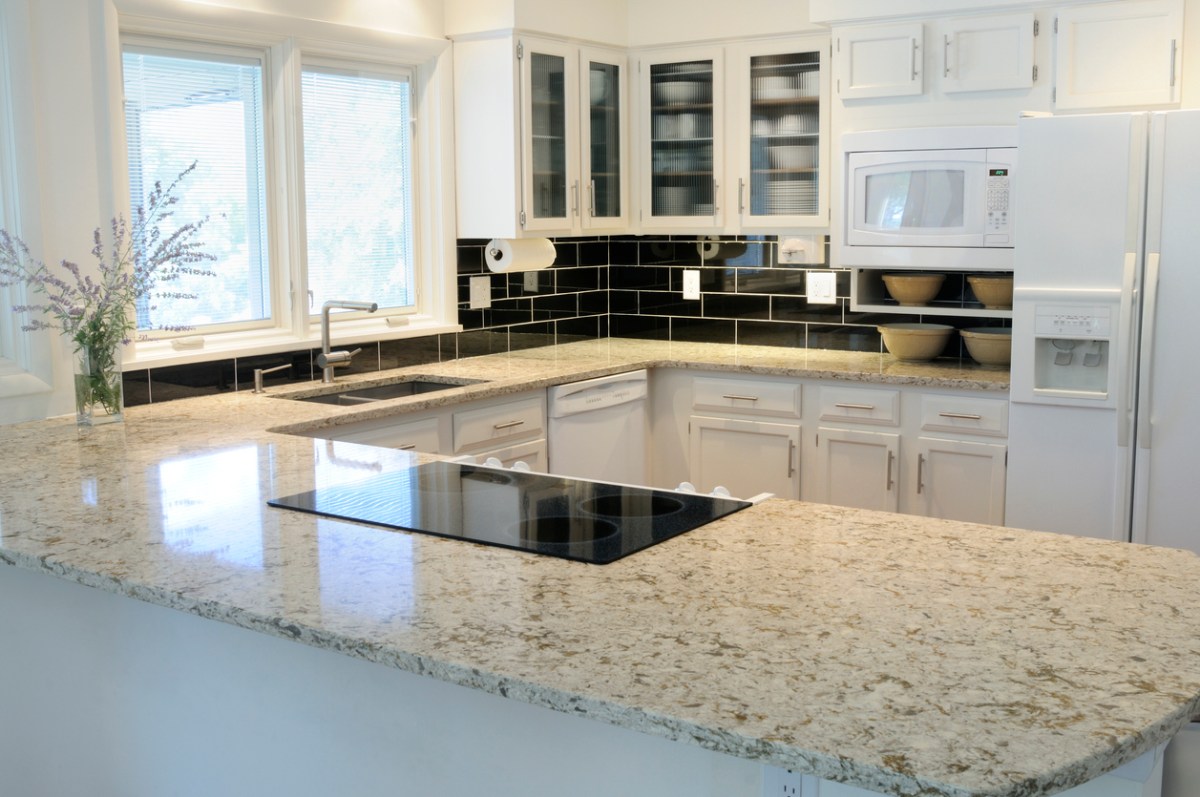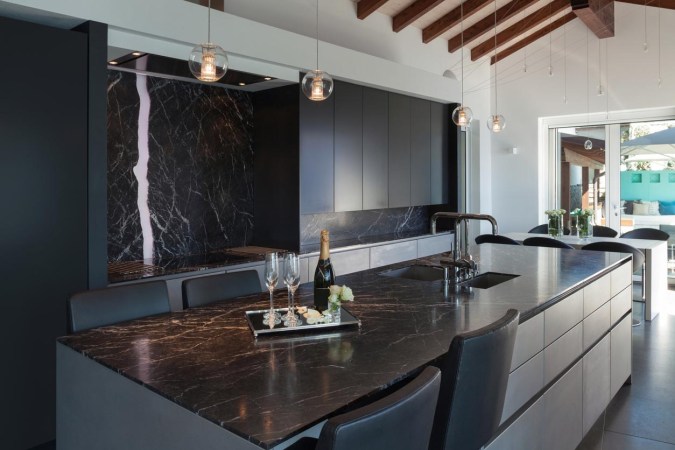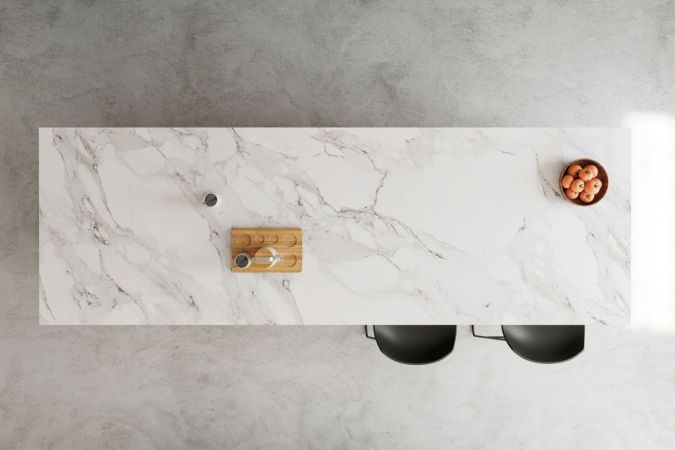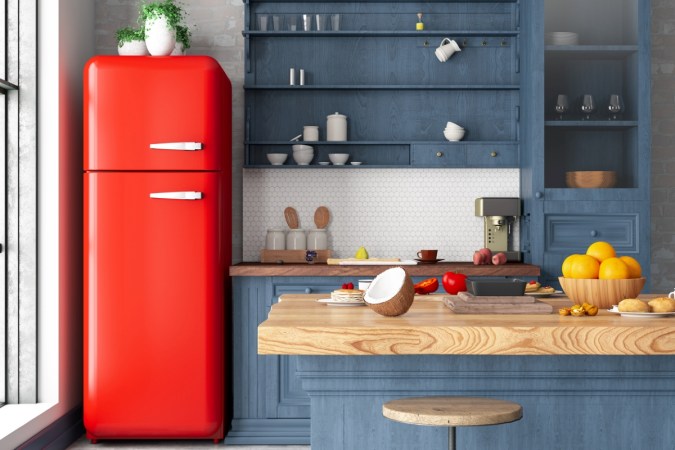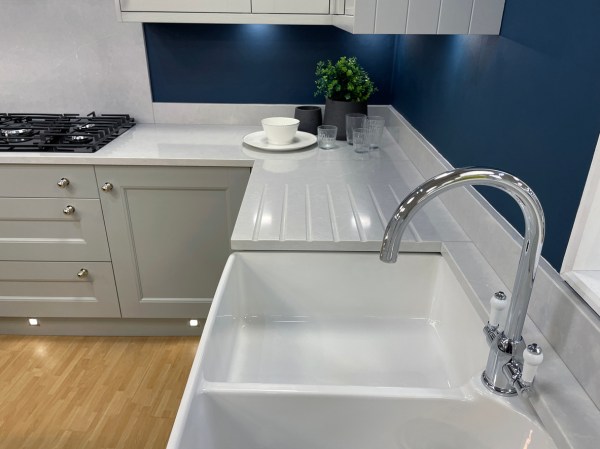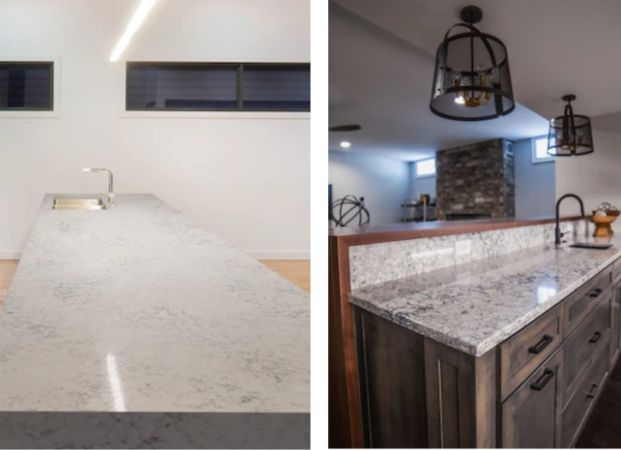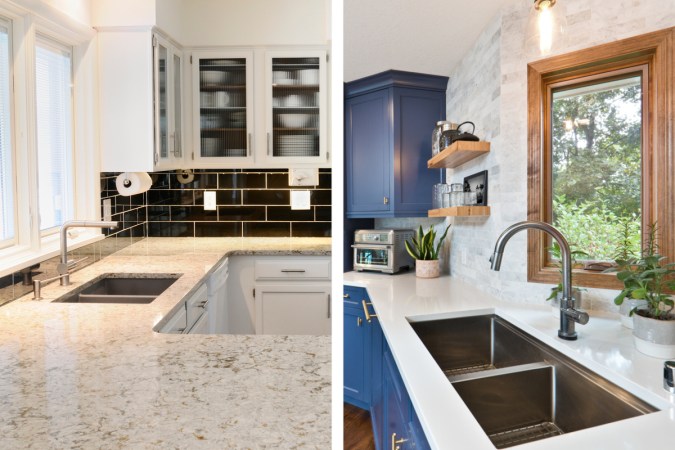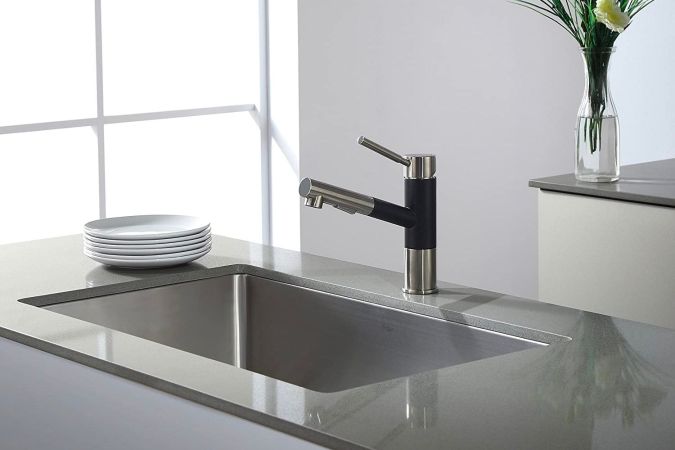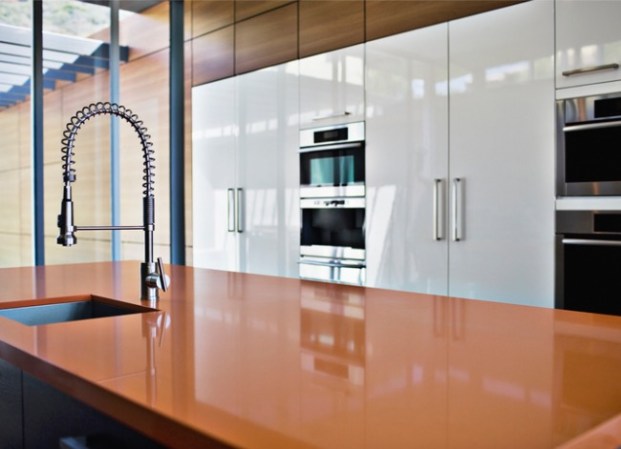We may earn revenue from the products available on this page and participate in affiliate programs. Learn More ›
Appearance is probably the number one reason why many people pick a particular type of countertop, but what about the underlying structure? How will it cope with hot pans or spills? How easy is it to keep clean? Does it need to be sealed regularly? How long is it likely to last?
Choosing the best countertop material for the way you use your kitchen is just as important as how it looks. In this article we’re investigating eight of the most popular options, looking at the technical aspects of their construction, and discussing what type of countertop is best for the kitchen in your home.
1. Quartz
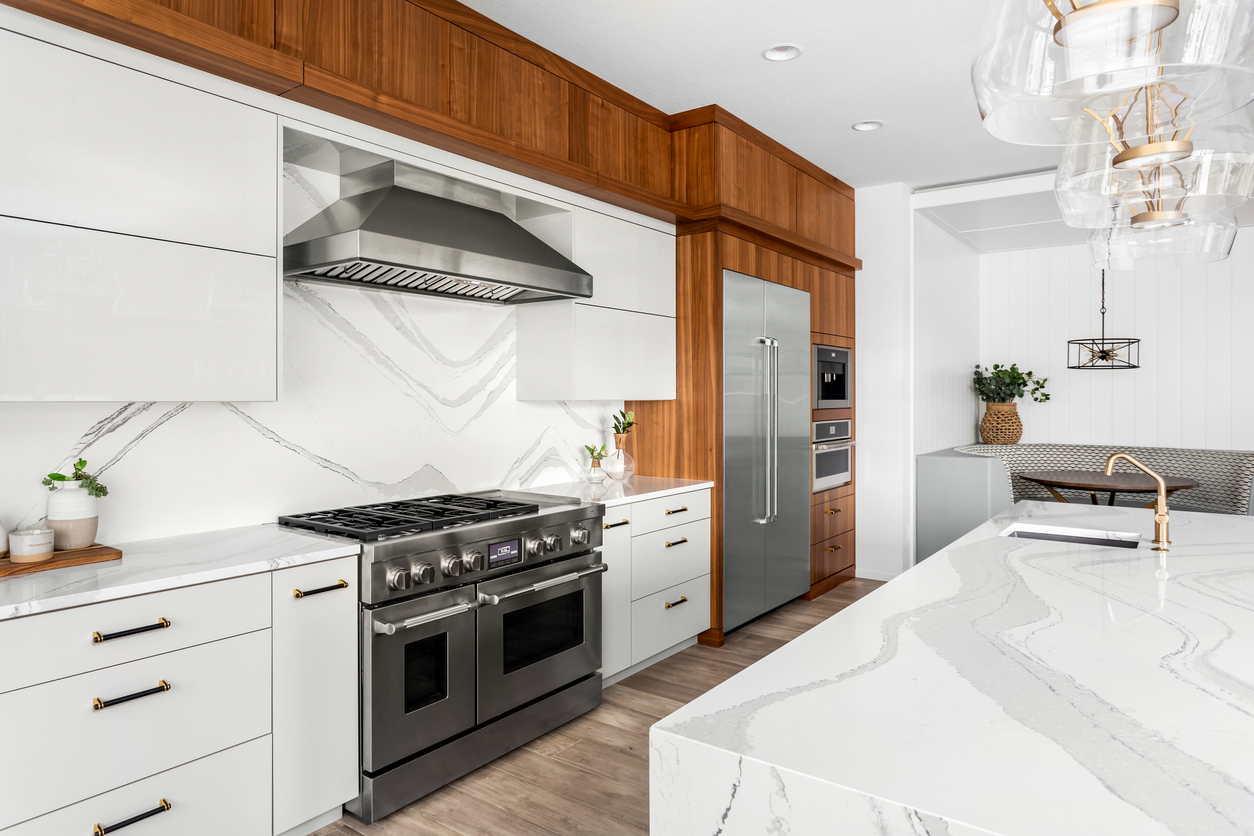
Quartz is undeniably one of the best countertop materials available in terms of both appearance and durability. While quartz countertops cost less than real marble, which they sometimes mimic, they are still a relatively expensive choice.
Quartz kitchen countertops are made from a blend of natural stone powder, synthetic resins, and pigments. They are combined at high temperatures, and under extreme pressures. The result is a material that looks and feels much like natural stone. It is hard-wearing, particularly easy to maintain, and available in an almost endless choice of patterns and colors. Quartz is also impervious to liquids and is resistant to staining, bacteria, mildew, and mold, so it’s often considered one of the safest materials for households with young children.
However, quartz isn’t indestructible. Hot pans should not be placed directly onto a quartz kitchen countertop because the heat can damage it. Additionally, quartz will eventually fade under direct sunlight, so it may not be the best choice as an outdoor countertop material.
Best For: Those looking for a natural stone aesthetic that is also easy to maintain.
RELATED: What’s the Difference? Quartz vs. Quartzite
2. Granite
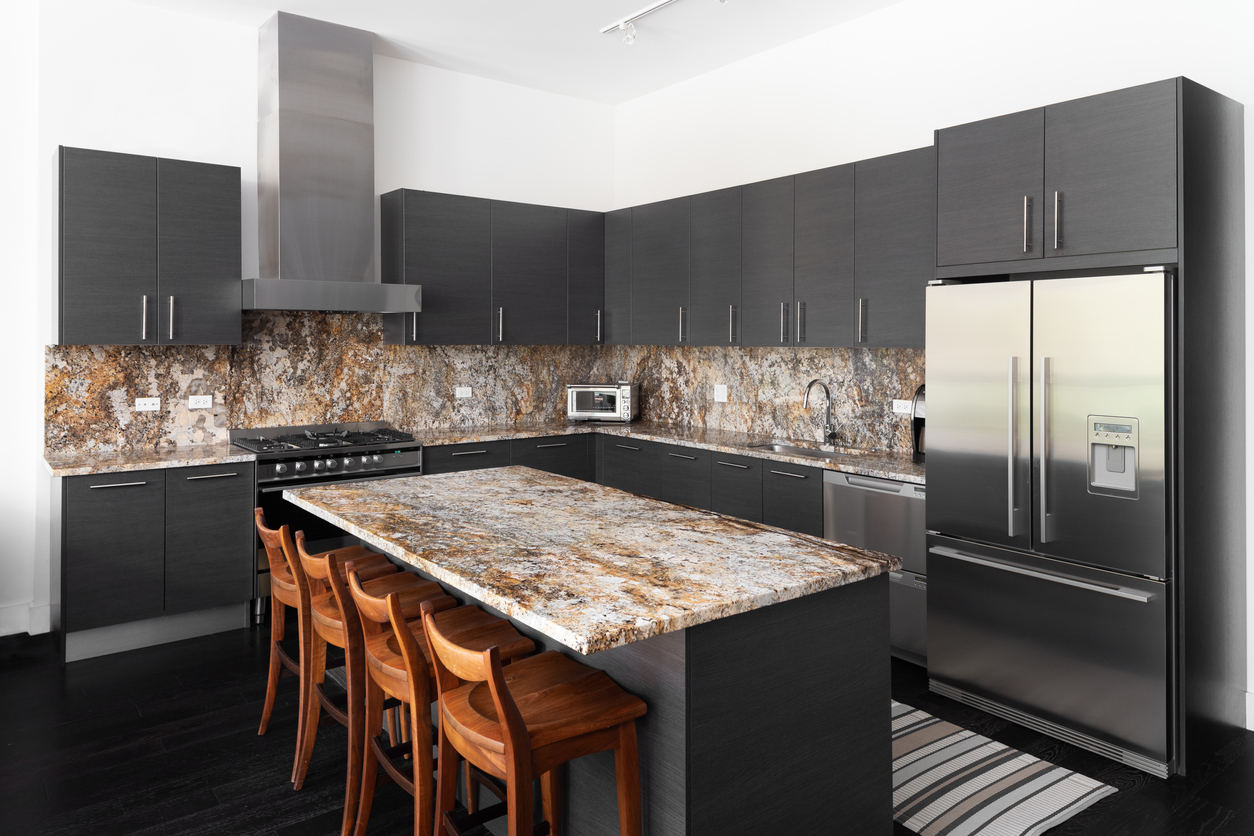
Like quartz, granite comes in a wide range of colors and patterns. It also vies with our number one choice for popularity. Granite is certainly beautiful to many, and, because it’s a natural material, every piece is unique which for some is an important consideration. It is also among the most durable countertops, and putting a hot pan on a granite kitchen countertop is perfectly safe. It is also highly resistant to cuts or scratches.
There are a few drawbacks with granite. It is porous, so it needs to be sealed annually to prevent staining. Since it is very heavy, professional installation is recommended. Although not a common problem, natural fissures can cause weaknesses. As a result, the patterns offered are usually dense, which doesn’t suit all kitchen styles. Also, unlike quartz, there are no ‘plain’ solid colors with granite.
Granite is often more affordable than quartz, though rare forms can command premium prices.
Best For: Large, traditional kitchens where granite’s natural beauty can be fully appreciated.
3. Laminate
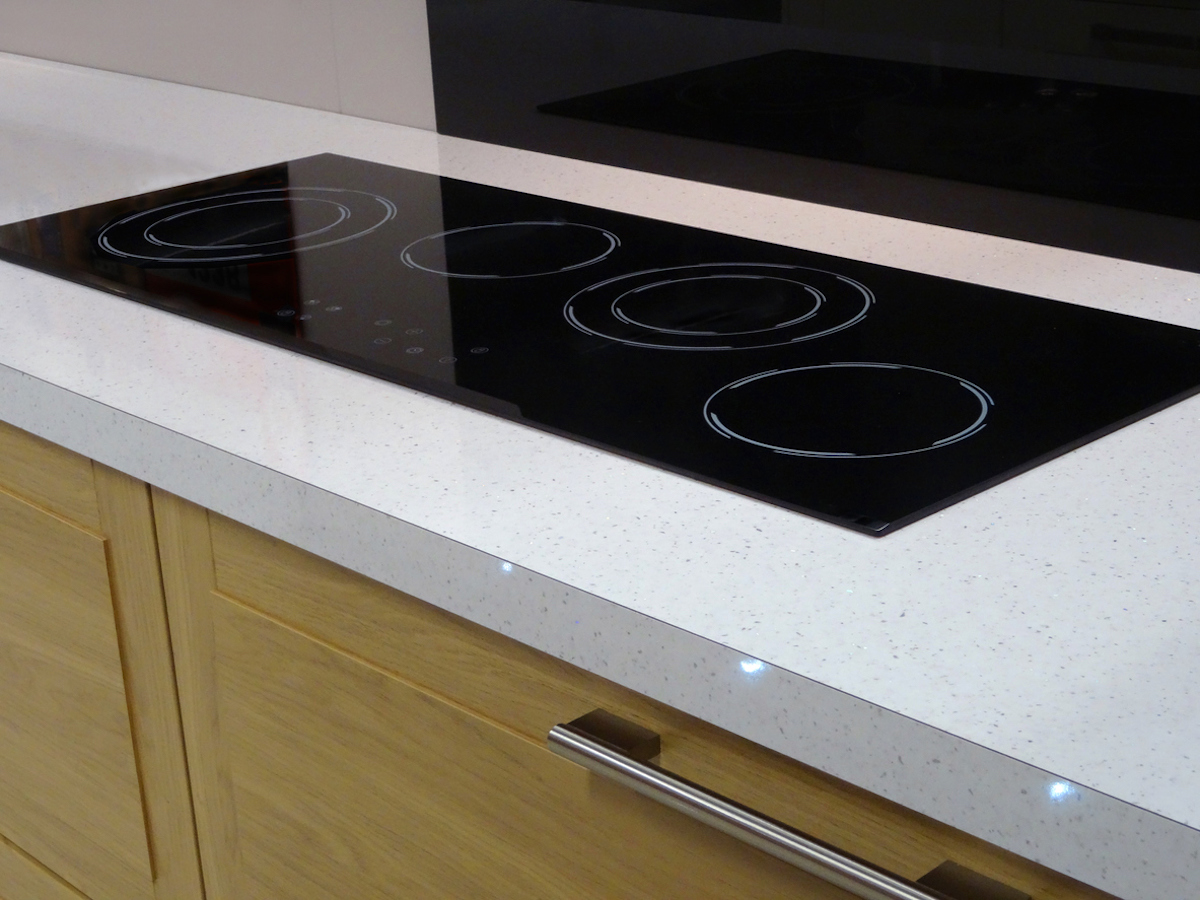
Laminate is usually one of the cheapest countertop materials available. It is constructed using a particleboard core with a laminate sheet glued to the outside. The laminate is made from paper or fabric fibers combined with melamine resin to make it strong and waterproof. In the past, laminate countertop materials had something of a poor reputation and were prone to surface peeling or swelling when wet. Thanks to modern adhesives and manufacturing techniques, though, these issues now rarely occur unless the laminate is badly damaged.
One of the benefits of laminate is that any pattern can be printed onto it, so it can effectively mimic granite, marble, or wood grain, and it’s available in almost any color imaginable. This makes it easy to find a laminate countertop to pair with modern kitchen styles, retro designs, or traditional looks. It is relatively easy to saw and drill and relatively lightweight, which makes it a very popular choice for DIY kitchen installations.
While it is easy to wipe clean, it doesn’t have the durability of quartz or natural stone. Hot pans should not be placed directly on the surface, and a cutting board should always be used to prevent surface scratching. While today’s laminates are quite tough, heavy impacts can chip the surface. Fortunately, repair and refinishing products are widely available.
Best For: DIY kitchen installations where budget is a major determining factor.
4. Marble
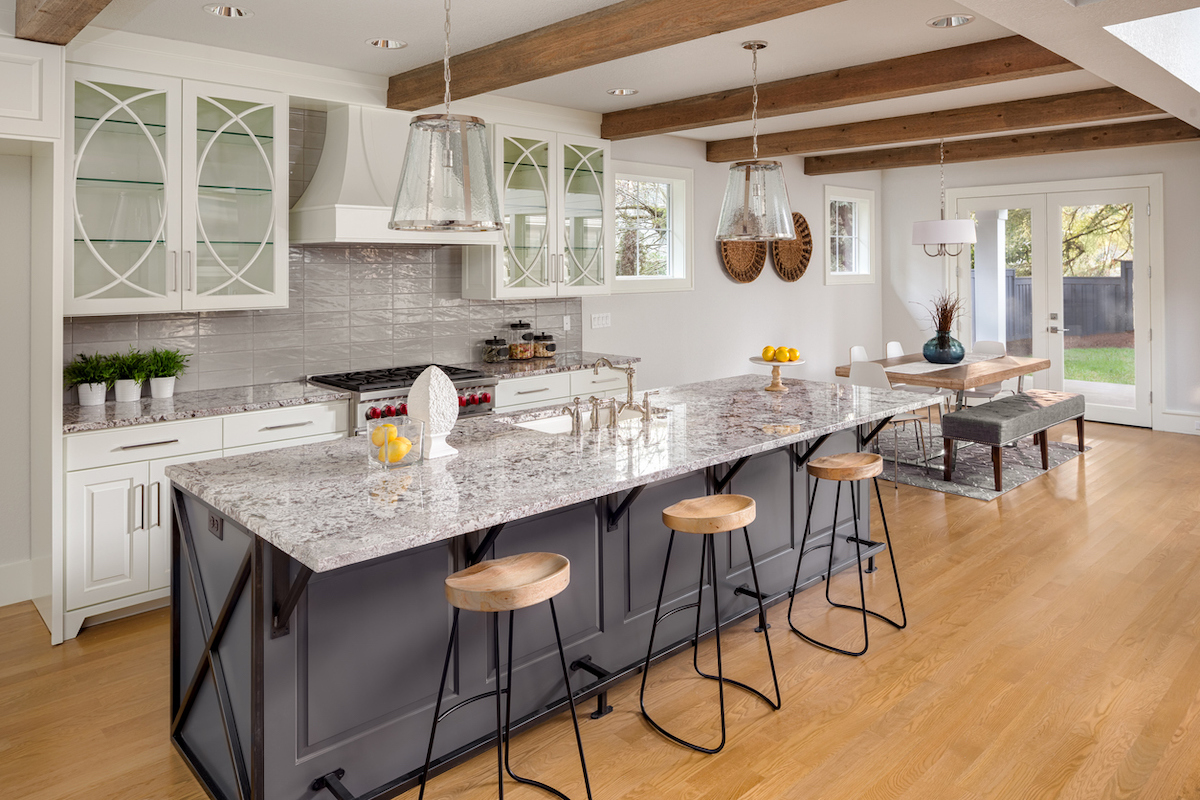
There isn’t a material more luxurious in the kitchen than high quality countertops made of marble. A material of unrivaled elegance, it is available in a wide range of colors, and each piece has unique veining that invariably creates stunning impact. When treated with care, it can last for generations.
Marble is unaffected by the heat from hot pans or oven trays, but, when comparing marble to quartz or natural stone countertops, it is more porous and much less forgiving. While it benefits from annual sealing to provide stain resistance, it is always a good idea not to let spills rest on a marble countertop for long. Liquids like wine, coffee, vinegar, and lemon and other acidic fruit juices can etch into the surface. Marble will also scratch fairly easily, although minor imperfections usually buff out reasonably well.
While marble is one of the most desirable types of countertops for a high-end kitchen, this material requires a considerable investment. It is even heavier than granite, and it should only be installed by suitably experienced professionals.
Best For: High-end, luxury kitchens for cooks who will take the time to keep it looking its best.
RELATED: A Beginner’s Guide to Engineered Stone Countertops
5. Butcher Block
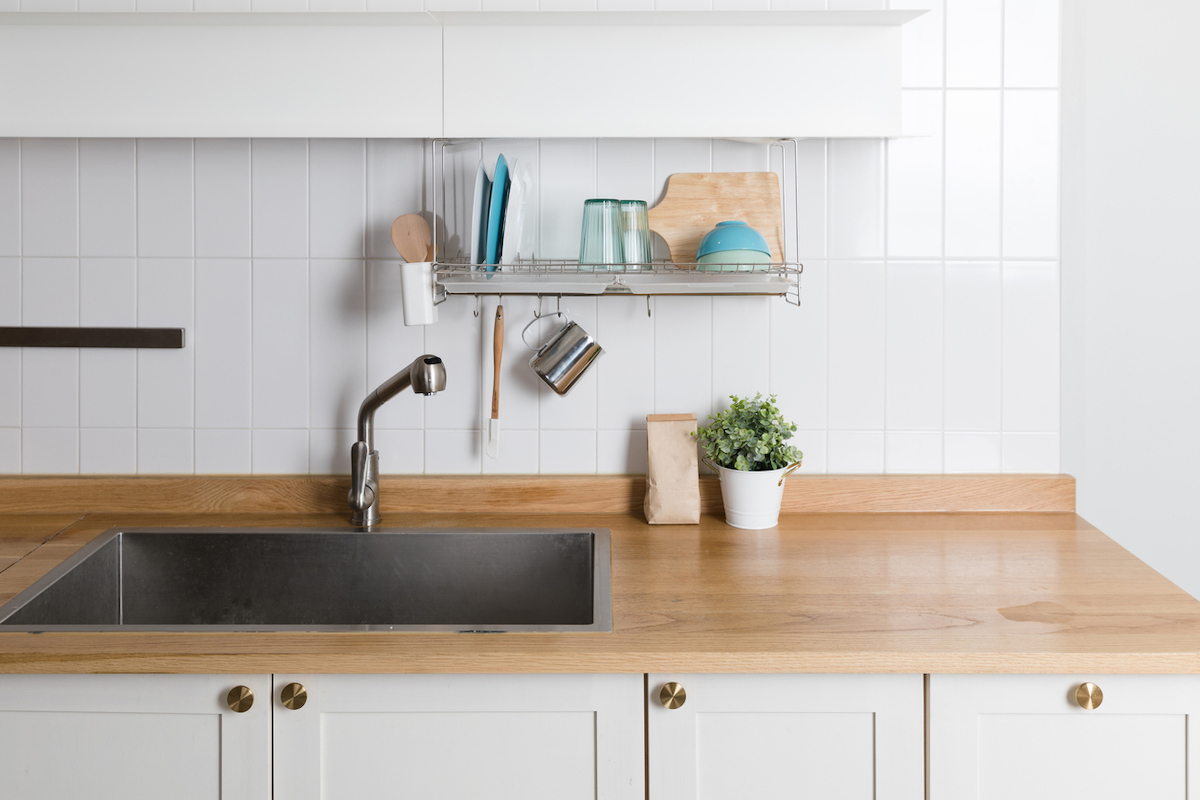
Butcher blocks take their name from their original use as a cutting surface for butchery. The wood blocks used in their construction are very good at absorbing the impact of heavy knives and cleavers, and the grain is—to some extent—self healing. Many woods are also naturally antibacterial.
Teak, which has natural protective oils, is sometimes used, though oak and maple are more common. These need regular oiling or sealing to protect the surface from stains. The type of wood will also majorly impact butcher block countertop price, which can vary tremendously.
Butcher block countertops are durable, but nicks and cuts will eventually make an impression. It is not difficult to sand out these marks, and refinish the surface, though many people simply accept small imperfections as part of the nature of the material. For those with restricted budgets, there are laminate versions that have the appearance of butcher block, but without the resilience.
Best For: Traditional, rustic, and farmhouse kitchens where a little wear and tear becomes part of the timeless charm.
6. Soapstone
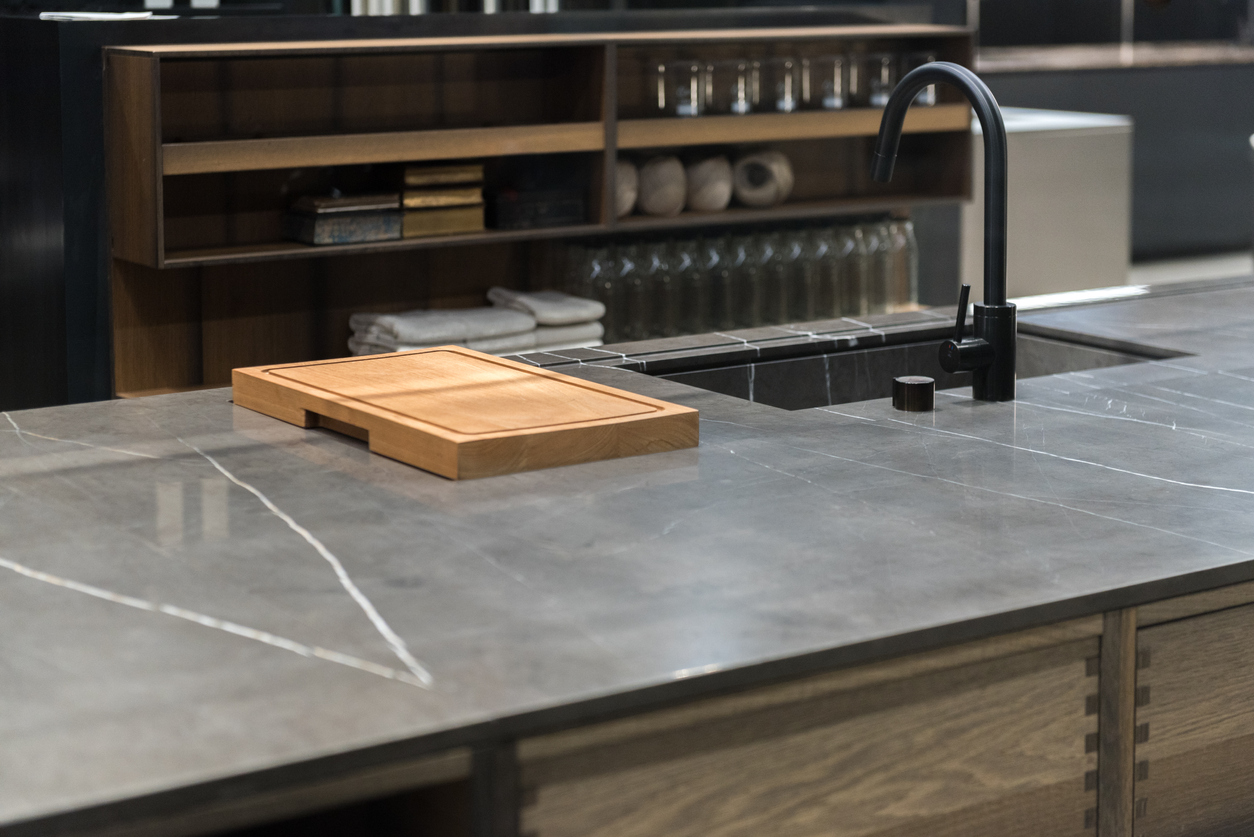
Soapstone may be one of the less common countertops for kitchens but this natural material is well worth considering, and it has proven history: Native Americans have used soapstone for cooking vessels and cutting boards for thousands of years. The predominant color is gray, though greens and blues are fairly common, and white and black can also be found. It often has veining much like marble.
There is a high percentage of talc in soapstone, giving it an unusual, almost soft feel, and hence the name. The surface oxidizes over time, developing a lustrous patina that adds to its appeal. Regular treatment with mineral oil helps to bring this out.
Soapstone offers good durability. It is nonporous, so it has good stain resistance without needing to be sealed. It is also naturally antimicrobial and completely unaffected by heat so hot pans will not leave marks. Although generally hard-wearing, it can scratch or abrade. Such marks can be buffed out, though doing so will affect the patina. Unless they are particularly obvious, they are usually best left alone.
Best For: The stain-resistance of quartz and the appearance of natural stone without the premium price of marble.
7. Terrazzo
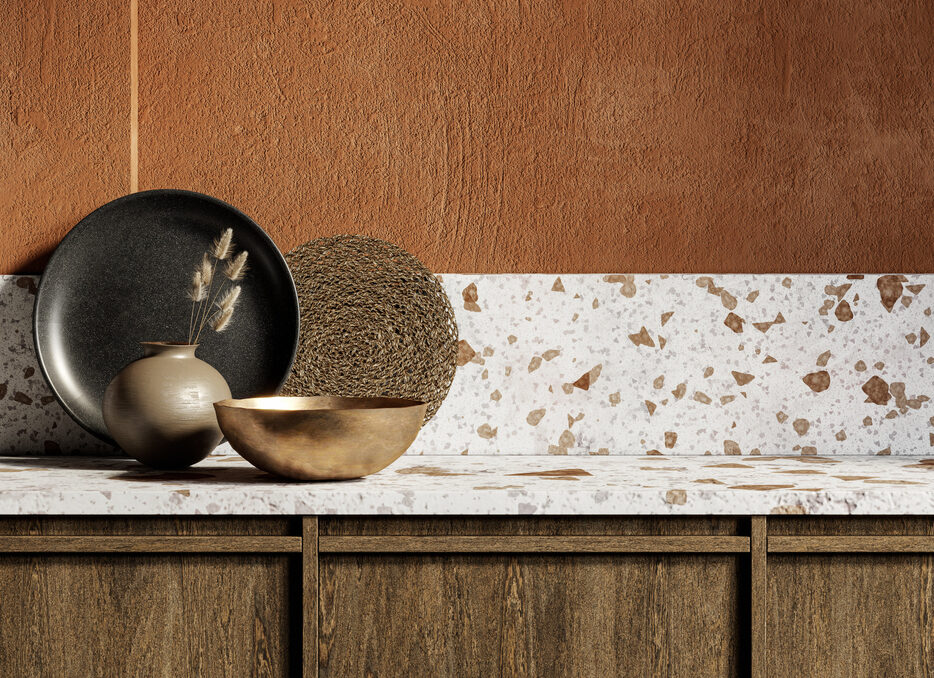
Terrazzo is the newest countertop material on our list, though it can actually trace its origins to mosaic workers in 16th century Italy where it was originally used as a flooring material. In fact, it is still popular as such. It can be made from chips of granite, marble, or quartz, and may also contain glass or metal fragments. These are bound with cement and resin, and may be polished to a high shine. This amalgam means terrazzo looks unlike any other material.
While the trend for terrazzo as a kitchen countertop material is new, it has some clear benefits. It has the durability associated with quartz, but is frequently less expensive. It is nonporous so it won’t stain, and it is highly resistant to heat. It is very tough, and also UV resistant so it won’t fade if used as an outdoor countertop material.
The use of recycled materials, and the lack of toxic volatile organic compounds (VOCs) means it also has more eco-friendly credentials than many alternatives. The appearance won’t appeal to everyone, but the only real drawback with terrazzo is that it can crack if not correctly installed, and it’s very difficult to repair.
Best For: A budget-friendly and unique departure from quartz or natural stone.
RELATED: The Best Countertop Installers
8. Stainless Steel
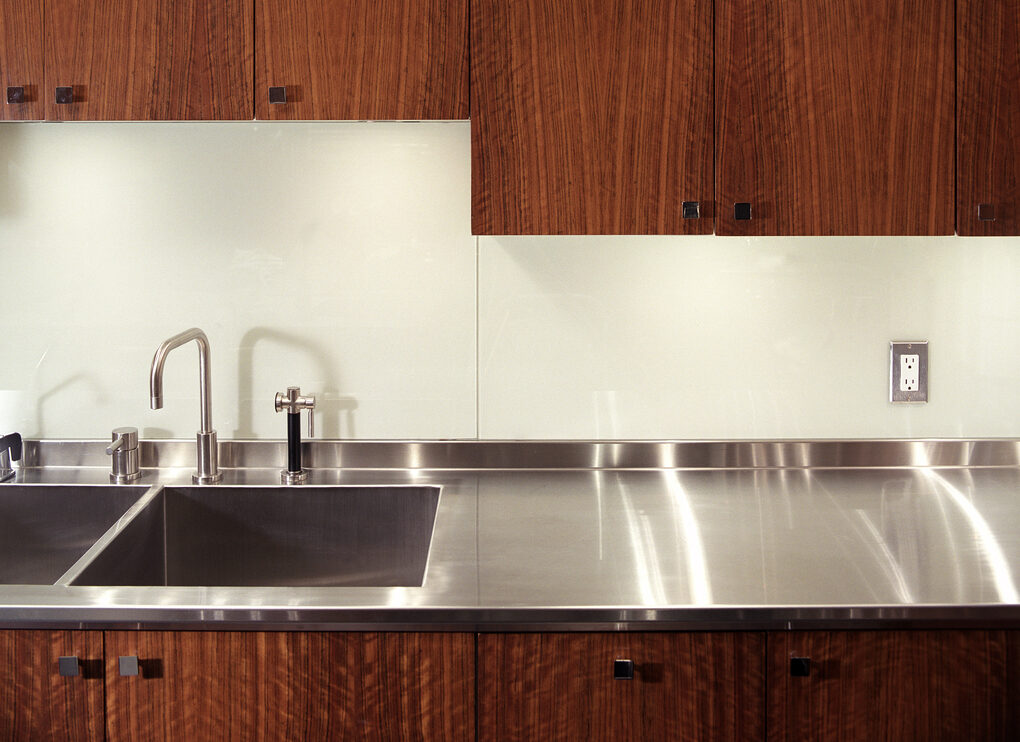
Stainless steel has long been considered the best countertop surface for professional chefs. The sleek, industrial look is used in commercial kitchens around the world because it is easy to maintain high levels of hygiene, and it offers outstanding durability. It is stainless by name, stainless by nature, resistant to mold and mildew, and easy to wipe clean. It is completely impervious to heat or liquids.
All of these benefits make stainless steel the countertop of choice among keen amateur chefs who would rather concentrate on preparing fine food than looking after the kitchen. The natural oils in fingerprints do leave marks though they do no damage, and require little effort to remove. The surface can be scratched but most see this simply as evidence of the kitchen being well used.
Best For: Enthusiastic cooks who favor a kitchen focused on hygiene and culinary excellence.

